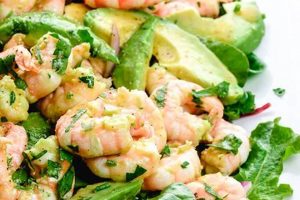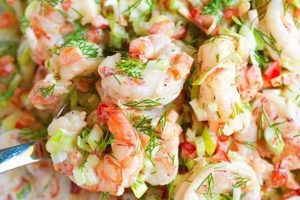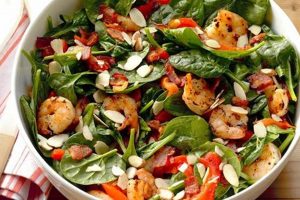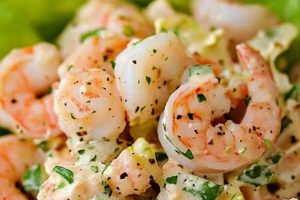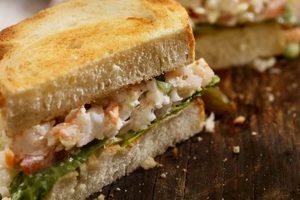A dish combining cooked shrimp, avocado, and typically other ingredients like vegetables, herbs, and a dressing, often served chilled. Variations exist, incorporating different seasonings, textures, and presentation styles, ranging from a simple mixture to more elaborate layered salads or appetizers. For instance, a simple version might include diced shrimp, cubed avocado, chopped red onion, cilantro, lime juice, and olive oil. More complex versions could add ingredients like tomatoes, corn, mango, or a creamy dressing based on mayonnaise or yogurt.
This type of salad offers a balance of nutritional value and refreshing flavors. Shrimp provides protein and omega-3 fatty acids, while avocado contributes healthy fats, fiber, and vitamins. The inclusion of fresh produce adds vitamins, minerals, and antioxidants. Historically, seafood and avocado combinations have been prevalent in coastal cuisines, particularly in Latin American culinary traditions. The rising popularity of healthy eating and the increasing availability of fresh ingredients globally have further propelled this dish’s widespread appeal.
Further exploration will cover variations in ingredients, preparation methods, nutritional information, and serving suggestions, offering a comprehensive guide to creating and enjoying this versatile dish.
Tips for a Superior Shrimp and Avocado Salad
Achieving optimal flavor and texture requires attention to detail throughout the preparation process. The following tips offer guidance for creating a truly exceptional dish.
Tip 1: Shrimp Selection and Preparation: Opt for high-quality, fresh or properly frozen shrimp. Ensure thorough thawing and gentle cooking to prevent rubbery texture. Overcooked shrimp detracts from the overall quality.
Tip 2: Avocado Ripeness: Select avocados that are ripe but firm. Slightly underripe avocados hold their shape better, while overripe ones can become mushy when mixed with other ingredients.
Tip 3: Preventing Avocado Browning: To prevent browning, prepare the avocado immediately before combining it with other ingredients. A light coating of lemon or lime juice can further inhibit oxidation.
Tip 4: Balancing Flavors: Consider the interplay of flavors between the shrimp, avocado, and other components. A citrus element, such as lime or lemon juice, enhances the natural sweetness of the shrimp and avocado. Herbs like cilantro, dill, or chives provide freshness and aromatic complexity.
Tip 5: Dressing Considerations: Choose a dressing that complements the salad’s ingredients. A light vinaigrette, a creamy cilantro-lime dressing, or even a simple olive oil and lemon juice mixture can work well. Avoid heavy dressings that might overpower the delicate flavors.
Tip 6: Texture Enhancement: Incorporating ingredients with contrasting textures adds interest to the salad. Chopped red onion, bell peppers, or celery provide a satisfying crunch.
Tip 7: Proper Chilling: Chilling the salad for a short period allows the flavors to meld and enhances the refreshing quality. However, avoid excessive chilling, which can dull the flavors and make the avocado too firm.
By adhering to these guidelines, one can elevate a simple combination of ingredients into a culinary delight, offering a balanced and flavorful experience.
These tips provide a foundation for creating a delicious and visually appealing salad. The following section offers variations and serving suggestions to further personalize the dish.
1. Fresh Ingredients
The quality of an avocado shrimp salad hinges directly on the freshness of its components. Subpar or improperly handled ingredients detract significantly from the overall flavor, texture, and enjoyment of the dish. Prioritizing ingredient quality is paramount to achieving a successful outcome.
- Shrimp Quality
Shrimp should ideally be purchased fresh and exhibit a firm texture, translucent flesh, and a mild, sweet aroma. If using frozen shrimp, ensure they are properly thawed and exhibit no signs of freezer burn or discoloration. The shrimp’s quality significantly impacts the salad’s overall taste and safety.
- Avocado Ripeness
Avocados should yield slightly to gentle pressure but not feel mushy. Underripe avocados lack flavor and have a firm, unpleasant texture, while overripe ones become overly soft and can impart a bitter taste to the salad. Selecting avocados at peak ripeness ensures optimal flavor and texture.
- Herbs and Vegetables
Using fresh, vibrant herbs and vegetables enhances both the flavor and visual appeal. Wilted or browning produce introduces off-flavors and detracts from the salad’s aesthetic quality. Crisp, brightly colored ingredients contribute to a more appealing and palatable final product. Examples include cilantro, red onion, and tomatoes.
- Citrus and Dressing Components
Freshly squeezed citrus juice provides a brighter, more vibrant flavor compared to pre-packaged varieties. Similarly, using fresh herbs and spices in dressings enhances the overall flavor profile. Fresh ingredients in the dressing ensure a balanced and nuanced flavor that complements the shrimp and avocado.
By prioritizing fresh, high-quality ingredients, the resulting avocado shrimp salad offers superior flavor, texture, and visual appeal. Attention to these details elevates the dish from simple to exceptional.
2. Balanced Flavors
A successful avocado shrimp salad hinges on a harmonious interplay of flavors. The inherent richness of avocado and the delicate sweetness of shrimp provide a foundation that requires careful balancing with other ingredients. Achieving this balance elevates the dish beyond a simple combination of components to a nuanced culinary experience. The following facets explore key elements contributing to a well-balanced flavor profile.
- Acidity
Acidity plays a crucial role in cutting through the richness of the avocado and enhancing the natural sweetness of the shrimp. Citrus juices, such as lime or lemon, are commonly used. Vinegars, like white wine or rice vinegar, can also contribute a subtle tang. The level of acidity should be carefully calibrated to provide brightness without overpowering the other flavors. For example, a squeeze of lime juice brightens the salad and complements the other ingredients without being overly sour.
- Saltiness
Salt enhances the overall flavor profile and balances the other taste components. It can be introduced through various means, including sea salt, kosher salt, or flavored salts. In addition to directly seasoning the salad, salty elements like capers, olives, or feta cheese can contribute complexity. However, over-salting can easily mask the delicate flavors of the shrimp and avocado, so moderation is key. A pinch of sea salt enhances the natural sweetness of the shrimp, while too much salt overwhelms the palate.
- Aromatics
Fresh herbs and spices introduce aromatic complexity and depth of flavor. Cilantro, dill, chives, and parsley are popular choices. Spices like cumin, chili powder, or paprika can add warmth and subtle heat. The choice of aromatics should complement the other ingredients and contribute to the overall flavor profile without being overpowering. For instance, fresh cilantro adds a bright, citrusy note that complements the avocado, while a touch of chili powder introduces a subtle warmth.
- Heat (Optional)
A touch of heat can add another dimension to the flavor profile. This can be achieved through the use of fresh chilies, chili flakes, or hot sauces. The level of heat should be carefully considered based on personal preference and the overall balance of flavors. A hint of jalapeo adds a pleasant kick without overwhelming the other flavors, while a large amount could make the salad unpalatable for some. The judicious use of heat adds complexity and interest to the final dish.
By carefully balancing these flavor components, an avocado shrimp salad transforms from a simple dish into a multi-sensory experience. The interplay of acidity, saltiness, aromatics, and optional heat creates a symphony of flavors that complement the core ingredients and elevate the overall culinary experience.
3. Proper Techniques
Proper techniques are essential for maximizing the quality and enjoyment of an avocado shrimp salad. These techniques encompass the handling of ingredients, cooking methods, and assembly processes. Their correct application directly influences the final dish’s flavor, texture, and presentation. Overlooking or misapplying these techniques can compromise the salad’s overall appeal and even pose food safety risks.
For instance, improper thawing of shrimp can lead to bacterial growth, while overcooking results in a rubbery texture. Similarly, failing to prevent avocado browning can result in an unappetizing appearance and diminished flavor. Dicing ingredients unevenly leads to inconsistencies in texture and cooking times. A concrete example is the importance of chilling the salad components separately before combining them to prevent the avocado from becoming mushy and the shrimp from warming prematurely. Another example is using a sharp knife to create clean cuts in the ingredients, enhancing the salad’s visual appeal and ensuring even distribution of flavors.
Mastery of proper techniques is therefore crucial for achieving a successful avocado shrimp salad. Careful attention to detail in each step, from ingredient selection and preparation to final assembly and presentation, ensures a flavorful, visually appealing, and safe-to-consume dish. These techniques are not merely procedural steps but integral components contributing to the overall quality and enjoyment of the culinary creation. Neglecting these foundational elements undermines the potential of the recipe and compromises the dining experience. The subsequent sections will delve into specific techniques related to shrimp preparation, avocado handling, and dressing preparation, providing practical guidance for achieving optimal results.
4. Textural Contrast
Textural contrast contributes significantly to the enjoyment of an avocado shrimp salad. The creamy textures of avocado and often the dressing provide a base against which contrasting textures create a more dynamic and engaging sensory experience. This interplay of textures elevates the dish from simple to complex, making each bite more interesting.
Consider the addition of crisp elements. Diced cucumber, chopped celery, or thinly sliced red onion introduce a refreshing crunch. Toasted nuts or seeds, such as slivered almonds or sunflower seeds, offer a satisfying nuttiness and further textural variation. Even incorporating a crunchy element like crumbled bacon can provide a salty, smoky counterpoint to the creamy avocado and succulent shrimp. These contrasting textures stimulate the palate and prevent the salad from feeling monotonous. For example, a salad composed solely of avocado, shrimp, and a creamy dressing might feel heavy and one-dimensional. However, the introduction of chopped cucumber and toasted pepitas transforms the experience, adding a refreshing crunch and satisfying nuttiness that complements the creamy and smooth elements.
Understanding the role of textural contrast allows for more deliberate and nuanced recipe development. One can strategically choose ingredients to achieve a desired balance of textures, enhancing the overall enjoyment of the avocado shrimp salad. Failure to consider textural variety can result in a dish that lacks complexity and interest, regardless of the quality of its individual components. The interplay of textures, therefore, represents a crucial factor in achieving a successful and satisfying culinary experience. This principle extends beyond mere recipe development; it speaks to a broader understanding of how textural elements contribute to the overall enjoyment of food.
5. Attractive Presentation
Attractive presentation elevates the perceived value and enjoyment of an avocado shrimp salad. While flavor and texture remain paramount, visual appeal significantly influences the overall dining experience. A thoughtfully presented salad stimulates appetite and enhances enjoyment before the first bite is even taken. This principle applies whether the salad serves as a light lunch, a starter, or part of a larger meal. A visually appealing arrangement suggests care and attention to detail, enhancing the perceived quality of the dish. For instance, a simple salad arranged artfully on a bed of crisp lettuce with strategically placed garnishes appears more enticing than the same salad haphazardly thrown together. The presentation transforms the perception of the dish, elevating it from mundane to something special.
Several techniques contribute to attractive presentation. Consider the choice of serving vessel. A shallow bowl showcases the vibrant colors and textures, while individual portions in small glasses or on crispbread offer a more elegant touch. Garnishes play a vital role. A sprinkle of chopped fresh herbs, a scattering of toasted nuts, or a drizzle of high-quality olive oil adds visual interest and complements the flavors. Color contrast enhances visual appeal. The green of avocado, the pink of shrimp, and the vibrant hues of other vegetables create a visually stimulating composition. Thoughtful arrangement, such as layering ingredients or creating height, further enhances the presentation. For example, a layered salad in a clear glass showcases the individual components and creates an appealing visual effect. Conversely, a dull, homogenous presentation can detract from the overall experience, even if the salad’s flavor is excellent.
Understanding the impact of presentation allows one to transform a simple avocado shrimp salad into a visually stunning culinary creation. This understanding extends beyond aesthetics; it recognizes the psychological impact of visual appeal on the dining experience. By employing these techniques, one can significantly enhance the enjoyment and perceived value of the dish, demonstrating an appreciation for detail and a commitment to culinary excellence. The effort invested in presentation communicates care and attention, transforming a simple meal into a more memorable and satisfying occasion. It reinforces the notion that dining is a multi-sensory experience, where visual appeal plays a crucial role alongside flavor and texture in contributing to overall enjoyment.
Frequently Asked Questions
This section addresses common inquiries regarding the preparation and enjoyment of avocado shrimp salad. Clarity on these points facilitates a more informed and successful culinary experience.
Question 1: What type of shrimp works best in this salad?
While various shrimp varieties are suitable, cooked, peeled, and deveined medium-sized shrimp are generally preferred for their balance of flavor and texture. Larger shrimp may require chopping for easier consumption.
Question 2: How can browning of the avocado be prevented?
Avocado browning results from oxidation. Minimizing exposure to air is crucial. Adding lemon or lime juice to the salad helps slow this process, as does preparing the avocado immediately before incorporating it into the mixture.
Question 3: What dressings complement avocado shrimp salad?
Light, flavorful dressings typically complement this salad best. Citrus-based vinaigrettes, creamy cilantro-lime dressings, or even a simple mixture of olive oil and lemon juice work well. Heavy, mayonnaise-based dressings can overpower the delicate flavors of the shrimp and avocado.
Question 4: Can this salad be prepared in advance?
While some components can be prepared ahead of time, it is generally recommended to assemble the salad shortly before serving to maximize freshness and prevent the avocado from browning. The dressing can be prepared separately and added just before serving.
Question 5: What are suitable accompaniments for this salad?
Avocado shrimp salad can be served as a standalone dish or accompanied by various complements. Crackers, crusty bread, or tortilla chips provide a vehicle for the salad. Serving it atop a bed of lettuce or alongside grilled vegetables enhances the meal’s nutritional value.
Question 6: How should leftover avocado shrimp salad be stored?
Leftovers should be stored in an airtight container in the refrigerator for up to 24 hours. However, the avocado may continue to brown slightly, even with proper storage. Consuming the salad promptly after preparation is recommended for optimal quality.
Understanding these key points empowers one to prepare and enjoy avocado shrimp salad with greater confidence and success. Attention to detail, from ingredient selection to proper storage, ensures an optimal culinary experience.
The following section offers a selection of variations on the classic avocado shrimp salad recipe, allowing for customization and exploration of diverse flavors and presentations.
Avocado Shrimp Salad Recipe
Exploration of the avocado shrimp salad recipe reveals a dish offering versatility and nutritional value. Emphasis on fresh, high-quality ingredients, balanced flavors, proper techniques, textural contrast, and attractive presentation contributes to a superior culinary outcome. From ingredient selection to preparation methods, each step plays a crucial role in the final product’s overall quality.
Avocado shrimp salad represents more than a simple combination of ingredients; it embodies a culinary experience enriched by attention to detail and a commitment to quality. Further culinary exploration and individual experimentation promise continued enjoyment and discovery within this versatile dish’s realm. The potential for variation and adaptation ensures its enduring appeal across diverse palates and culinary preferences.

